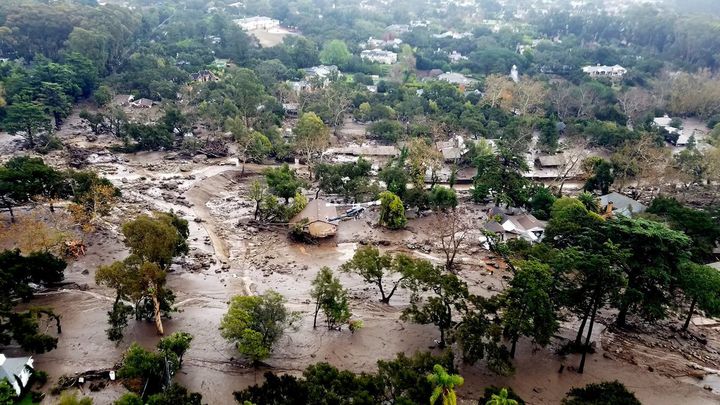At least 17 people have died and several remain missing following the powerful mudslides that swept through the Southern California community of Montecito earlier this week.
It’s hard to grasp that such a deadly tragedy could strike an area that was just scorched by the largest wildfire in recorded state history, but the two disasters are linked.
Here’s what you should know about the crisis unfolding:
What are mudslides, and why are they so dangerous?
Mudslides, referred to as debris flows by scientists, occur on hillsides and steep slopes when heavy rains pummel the soil, loosening and liquifying it into a fast-moving mud dragged down hillsides by gravity.
That deluge engulfs the loose debris, trees and boulders in its path, becoming a barrage of detritus powerful enough to wipe out entire communities downstream.
″[I]t’s like the sort of mud that will suck the boots right off your feet,” Southern California Public Radio reporter Sharon McNary said Wednesday from Montecito.
The flows can reach speeds of up to 35 miles per hour, according to the U.S. Geological Survey.

“Debris flows can be lethal because of their rapid onset, high speed of movement and the fact that they can incorporate large boulders and other pieces of debris,” the USGS explains. “They can move objects as large as houses in their downslope flow or can fill structures with a rapid accumulation of sediment and organic matter. They can affect the quality of water by depositing large amounts of silt and debris.”
Landslides occur in every state but are most common along the West Coast, in the Intermountain Region, Alaska, Hawaii and hilly parts of the East Coast.
How do recent wildfires increase the risk of mudslides?
Mudslide risk is higher on land recently scarred by wildfires, such as the recent burns in California. Several factors are at play here.
Wildfires wipe hillsides clean of vegetation that would typically anchor soil in its place. The roots of trees that are still standing were often killed in the wildfires and not as secure in the ground, allowing them to be swept up into the mudslide.
Wildfires also create “burn scars” in which the ground is so scorched it becomes hydrophobic. Instead of being absorbed into the soil, the water slicks off the hill and picks up loose topsoil and debris. This phenomenon is worsened by the lack of trees, which would typically catch rain as it falls and slow its path to the ground.

With the largest wildfire in state history still in residents’ rearview mirrors, this double whammy is about as bad as it gets. Last month’s Thomas fire, which authorities are still working to fully contain, has burned 281,000 acres in Santa Barbara and Ventura counties.
When a forecast of heavy rain in the region emerged Sunday, meteorologists warned that mudslides could develop and become treacherous.
Why weren’t people more prepared?
The exact timing of mudslides is hard to predict, and they’re nearly impossible to mitigate, according to the USGS. That poses a dilemma for the residents who must decide whether to respond to warnings and to the officials who would send the warnings out.
Many people in the mudslides’ path had just returned home after being forced to evacuate during the fires. Worried residents facing “disaster fatigue” might not take the emergency alerts seriously, and officials chose not to send out emergency alerts to cellphones until after the flooding had begun.
There “isn’t an exact science” for predicting the scope of a disaster, Santa Barbara County Sheriff Bill Brown said.
Many residents probably couldn’t grasp the scope of how dangerous mudslides can become, McNary told PBS NewsHour.

“You can be in a place that looks perfectly safe, that looks kind of flat,” she said. “You cannot imagine what it’s like to be at the bottom of a funnel of literally acre-feet of watery mud, and it comes very, very fast. I was in a mud flow yesterday, and it went from a wash channel being 6 inches of water to being 10 feet of water full of boulders.”
Even just a small misstep can be fatal. When Josie Gower, 69, opened the front door of her Montecito home, she was fatally swept downhill for miles.
“I told her to stay on the second floor, but she went downstairs and opened the door and just got swept away,” her son, Hayden Gower, told KSBY.
How does this mudslide stack up to others?
These Southern California mudslides will likely go down as some of the worst in recent state history.
By comparison, the 2005 mudslide in La Conchita, California, killed 10 people and destroyed 13 houses, while a 1995 one in the same city destroyed nine homes but caused no fatalities.
The 2014 mudslides in Oso, Washington, about 60 miles north of Seattle, are regarded as among the worst in U.S. history. The disaster claimed more than 40 lives and dozens of homes and cut off a main roadway in the area for months.


